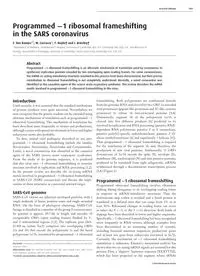
2004 Programmed _1 ribosomal frameshifting in the SARS coronavirus PDF
Preview 2004 Programmed _1 ribosomal frameshifting in the SARS coronavirus
Research Colloquia 1081 Programmed −1 ribosomal frameshifting in the SARS coronavirus F. Dos Ramos*1, M. Carrasco*, T. Doyle† and I. Brierley† *Department of Medicine, Addenbrooke’s Hospital, University of Cambridge, Box 157, Cambridge CB2 2QQ, U.K., and †Division of Virology, Department of Pathology, University of Cambridge, Tennis Court Road, Cambridge CB2 1QP, U.K. Abstract Programmed −1 ribosomal frameshifting is an alternate mechanism of translation used by coronavirus to synthesize replication proteins encoded by two overlapping open reading frames. For some coronaviruses, the mRNA cis-acting stimulatory structures involved in this process have been characterized, but their precise contribution to ribosomal frameshifting is not completely understood. Recently, a novel coronavirus was identified as the causative agent of the severe acute respiratory syndrome. This review describes the mRNA motifs involved in programmed −1 ribosomal frameshifting in this virus. Introduction Until recently, it was assumed that the standard mechanisms of protein synthesis were quite universal. Nevertheless, we now recognize that the genetic readout can be extended using alternate mechanisms of translation such as programmed −1 ribosomal frameshifting. This mechanism of translation has been described more frequently in viruses and prokaryotes, although a more widespread involvement in lower and higher eukaryotes seems also probable. To date, animal viral pathogens described to use pro- grammed −1 ribosomal frameshifting include the families Retroviridae, Astroviridae, Flaviviridae and Coronaviridae. Lately, a novel coronavirus was identified as the causative agent of the SARS (severe acute respiratory syndrome). From the study of its genome sequence, it is predicted that this virus uses −1 ribosomal frameshifting to translate enzymes involved in replication and RNA processing [1,2]. In the present review, we describe the cis-acting mRNA motifs involved in programmed −1 ribosomal frameshifting in SARS-CoV (SARS coronavirus) and discuss the impli- cations of these structures as a potential antiviral target. SARS-CoV genome SARS-CoV virions are spherical enveloped particles, with a single molecule of linear, positive-sense and single-stranded RNA. On the basis of phylogeny clustering, SARS-CoV lineage is classified as a member of the group 2 coronaviruses. Its genome is approx. 29.7 kb in length and encodes 15 recognizable ORFs (open reading frames) flanked by 5′- and 3′-untranslated regions [1,2]. The replicase gene (265– 21 485 nt, isolate Tor2) comprises two overlapping ORFs (1a and 1b) that encode the polyprotein 1a and the fused polyprotein 1a/1b, translated by programmed −1 ribosomal Key words: coronavirus, pseudoknot, recoding, ribosomal frameshifting, severe acute respiratory syndrome (SARS). Abbreviations used: IBV, infectious bronchitis virus; ORF, open reading frame; SARS, severe acute respiratory syndrome; SARS-CoV, SARS coronavirus. 1To whom correspondence should be addressed (email
